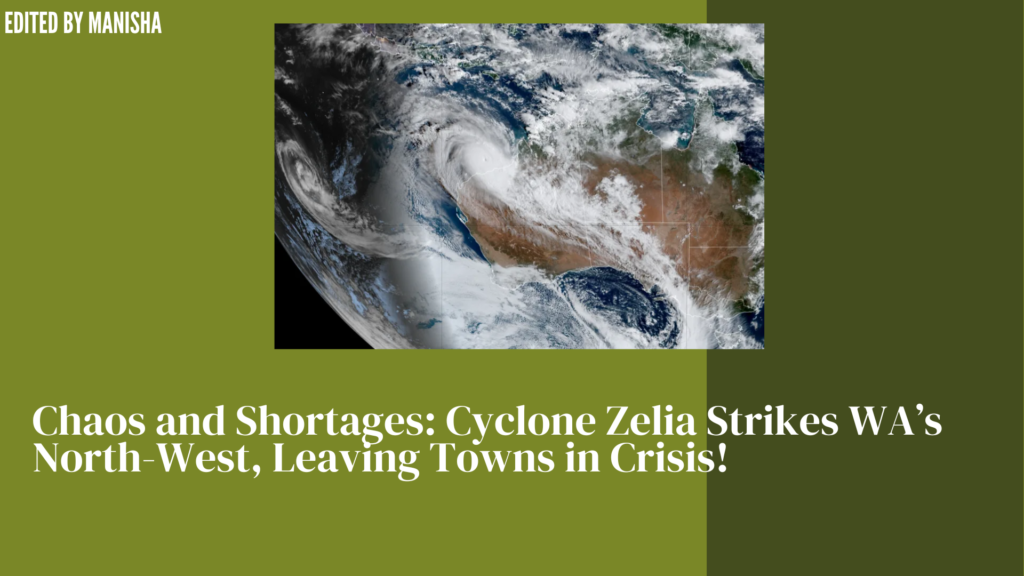
Supermarket shelves across Western Australia’s north-west have been depleted following the impact of Tropical Cyclone Zelia. The primary freight route to Broome has been submerged due to flooding, cutting off supply deliveries, and it’s uncertain when the roads will reopen.
Authorities are increasing their efforts to assist flood-affected areas, particularly around Port and South Hedland, and at local pastoral stations that faced the full force of the storm.
Inland communities, such as Marble Bar and Nullagine, are preparing to face extended isolation as flooding persists, with some areas possibly cut off for weeks.
The cyclone, which made landfall on Friday as a Category 4 storm, hit the De Grey River mouth east of Port Hedland. While Port and South Hedland avoided the worst damage, the pastoral stations to the east experienced severe impacts.
Major Freight Route Closed
Great Northern Highway, a key transport route connecting northern WA to the south, has been shut since Thursday. With the highway impassable, towns like Broome are seeing empty supermarket shelves as fresh produce can’t be delivered.
Coles confirmed they have measures in place to send stock via Darwin to Broome and Kununurra, working alongside DFES and the state government to expedite supply efforts. “We’ve rerouted stock via South Australia and the Northern Territory to ensure essential groceries reach affected areas,” a spokesperson said.
Stock was delivered to South Hedland over the weekend, with more expected in Hedland, Karratha, and Tom Price by Monday.
Meanwhile, Woolworths has experienced delivery delays, and has imposed product limits at its Broome store. “We urge customers to be considerate and only purchase what they need,” a spokesperson said. “Our supply team is ready to deliver once conditions allow.”
Unclear Timeline for Highway Reopening
The Great Northern Highway remains closed with no clear timeline for reopening, though efforts are being made to resupply affected towns. Additionally, assessments are underway in Warralong, a remote community about 120 km southeast of Port Hedland, where 63 residents were evacuated due to flooding.
DFES crews have flown in to assist with damage assessments and evacuate some elders from the area.
“I Don’t Know What to Eat”
Chea, a Broome resident who moved there a year ago, expressed shock at the empty shelves. “I’ve never seen this before—there’s basically nothing: no eggs, no fruits, nothing. I honestly don’t know what to eat,” she said.
Ian, who relocated from Perth just days ago, also noted the impact of the shortages. “It feels like the COVID situation again, but with the government needing to step up and ensure resources are being used to prevent this,” he said.
Inland Communities Brace for Isolation
Marble Bar and Nullagine are also isolated, with residents preparing for extended periods of being cut off. Marble Bar’s John Appleby described the damage caused by heavy rainfall, stating, “We dodged the worst of the winds, but I expect we’ll be stuck for at least a week, possibly more.”
Station Damage and Recovery Efforts
Mark Bettini, who runs De Grey station near Port Hedland, reported that while the station’s houses withstood the storm, a newly built shed housing essential machinery was destroyed. “There’s significant damage to machinery, but luckily no one was hurt,” he said. Despite some damage, he noted that the loss of cattle was still being assessed, though he expected it to be minimal.
Bettini is moving remaining cattle to higher ground to mitigate further losses. “It’s about making life easier for the ones we can save,” he said.
Flooding Risks Continue
Flood levels in the De Grey River are expected to continue rising until mid-next week. Bettini warned that additional storms could exacerbate the situation, creating a dangerous scenario if another cyclone strikes while the river is already full.
Efforts to assist the region continue, with DFES crews helping with recovery at De Grey Station and nearby Carlindie Station, which also sustained significant damage.
Barry Harrison from the Hedland SES reported about 40 outstanding assistance requests, most related to fallen trees. “Some of these trees are massive, and clearing them requires special equipment,” he said, noting that local crane companies have been essential in moving them.